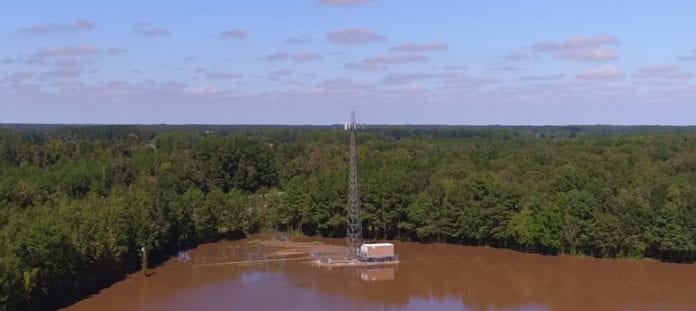Verizon Wireless is using drones to help with cell site inspections from the air in North Carolina and South Carolina to survey areas impacted by severe flooding from Hurricane Matthew, the telecom company wrote in a blog post. The quadcopter used for the inspections is an unmanned aerial system operated by Measure UAS to inspect cell sites in difficult-to-reach locations and share information on any damaged equipment.
“We understand how vital wireless communication is to connect with loved ones, reach out for help and start the long process of recovery during and after an event like Hurricane Matthew,” said Nicki Palmer, chief network officer at Verizon Wireless. “While we were able to access most sites quickly to assess damage, some sites were not accessible to us due to extreme flooding. We are very pleased that we now have this new tool to add to our already extensive list of preparatory and recovery efforts to help inspect our network assets and expedite recovery time.”
The UAS is able to both record and livestream high-definition video and high-resolution photographs of a cell site. The first flight to a site surrounded by water near Elm City, North Carolina, and the Tar River Reservoir showed engineers that the base station equipment – which was elevated on stilts – was not underwater and had not suffered visible damage.
After determining the site was safe to access, Verizon Wireless’ network team secured an air boat and refueled the generator, bringing the site back into service in a few hours.
Steps to ensure stable network
Here are a few steps Verizon’s network team takes to ensure reliability:
- Buildingredundant systems into the network, including battery backup and generators at cell sites so they can run without commercial power;
- Prearranging refueling operations to keep network facilities running;
- Prestaging equipment for faster repairs and having engineers and technicians on 24-hour standby as needed;
- Reinforcing equipment and buildings to withstand water and strong winds; and
- Using new technology, including drones, to help access facilities in inaccessible locations to speed recovery.
“Our network had less impact and a faster recovery time vs. the competition’s networks,” Palmer said. “Customers count on our service – we take that responsibility very seriously.” According to Palmer, more than 99% of the company’s cell sites in the Carolinas are up and running serving customers.
Trial with drones
Verizon completed cell site inspection trials earlier this year in New Jersey, providing 3-D imagery and system performance data via UAS/drone. Now the company has several vendors to aid in it’s network maintenance and operations.
Measure is operating the flights with Federal Aviation Administration authorization and uses a two-person crew that includes a ground pilot for the UAS and a visual observer of the operation for safe, legal and insured operations.
Last week, Verizon Wireless conducted the first trial with Verizon’s Airborne LTE Operations during an emergency management and disaster recovery exercise in Cape May, New Jersey. The exercise simulated how Verizon’s network can provide 4G LTE coverage from a 17-foot wingspan unmanned aircraft system, operated by American Aerospace Technologies, to first responders in an area impacted by a severe weather event where no wireless service is available. While this is the first simulation in an emergency scenario, AATI and Verizon Wireless are conducting trials nationally, testing connectivity between manned and unmanned aircraft and Verizon’s 4G LTE network including in-flight connectivity.

